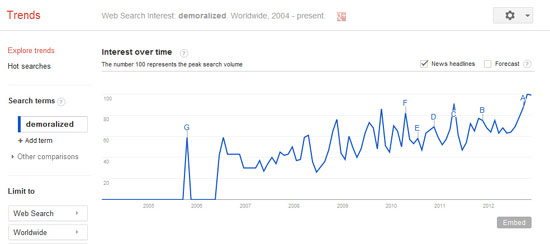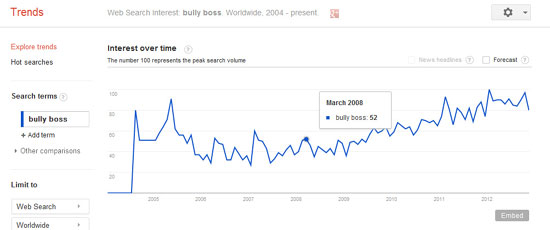Months ago, I posted an essay to this blog about the plight of demoralized employees. Surprisingly, that one essay generated more organic traffic than any other article, even though this site is not optimized for those search terms.
Curious to know whether this phenomenon was unique to my blog or part of a broader trend, I decided to do a little research. Using Google Trends, a research tool that shows search popularity for a specific keyword, I looked at trends from 2004 to today. First I searched for the term “demoralized employee,” but Google Trends didn’t have data on that term, so I started more broadly and then drilled down to examine root issues.
Search term: Demoralized
As you see below, search volume for the term “demoralized” has increased steadily over a long period of time. This trend line is especially interesting for employers and HR professionals because it reflects changing consumer and employee sentiment. Here we see why Google Trends is such a tremendously valuable tool to understand evolving societal attitudes.
Search term: Boss Bully
Digging deeper, I explored possible causes for an increase in demoralized workplace sentiment because my popular essay was about a demoralized employee. As you see below, in March of 2008, Google’s search volume for the term “Boss Bully” was 52 on a scale of 100. In January of 2012, that same term peaked at 100. This should raise a red flag for employers.
However, additional research shows workplace bullying is more of a consistent trend. The Workplace Bullying Institute conducted national surveys in 2007 and 2010 in which 35% of the adult Americans (an estimated 54 million workers) reported being bullied at work.
Furthermore, 15% of respondents said they witnessed bullying and were upset by it. This second number is concerning because it demonstrates erosion to corporate culture. When cultural values are ignored by a powerful manager, employee morale and trust suffers.
Female bullies in the workplace
As a graduate of an all-women’s college, it pains me to say that my own career has been largely supported by men, not by women. Peggy Klaus, a leadership coach explained the plight of female workplace competition in her 2009 New York Times Article, A Sisterhood of Workplace Infighting. In it, Peggy said,
A pink elephant is lurking in the room, and we pretend it’s not there. For years, I have heard behind closed doors from women — young and old, up and down the ladder — that we can be our own worst enemies at work.
Instead of helping to build one another’s careers, they sometimes derail them — for example, by limiting access to important meetings and committees; withholding information, assignments and promotions; or blocking the way to mentors and higher-ups.
A recent study by the Workplace Bullying Institute examining office behaviors — like verbal abuse, job sabotage, misuse of authority and destroying of relationships — found that female bullies aim at other women more than 70 percent of the time.”
In an Forbes article that ran earlier this year called, Why Women are the Worst Kind of Bullies, author Ruchika Tulshyan said,
Girls are taught to be critical about each other from adolescence, and it’s particularly vicious among working women; from playing favourites to badmouthing colleagues.”
The article cites Debra Falzoi, a communications coordinator who was bullied out of her job by a female boss at Boston University. Falzoi said,
‘My female bully lied and gossiped about me and others. She used all indirect tactics. I have seen men also use indirect bullying tactics, but they’re much less frequent, and they have seemed solely to protect their ego rather than proactive moves to sabotage.’
According to the article, Falzoi reported incidents directly to her manager who did nothing to help, despite the fact that others had also complained about the same women.
The article also cites a 2010 survey by the Workplace Bullying Institute which found that workplace bullying is four times more common than sexual harassment and racial discrimination. When the bully is a manager, there’s no limit to the destruction she can inflict. The Workplace Bullying Institute says that bullies choose targets who threaten them, and forty percent of targets never report the bullying.
Interestingly, the Forbes article cited above recently became the topic of a LinkedIn discussion in the Professional Women’s Network. So far, more than 430 women have commented in this discussion.
Bullying costs millions in lost productivity
An article in the American Sociological Review, cited in a 2008 Washington Post article entitled, Most Diversity Training Ineffective, Study Finds, said that U.S. companies spend $200 to $300 million per year on diversity training. These substantial investments in diversity training are specifically intended to improve business performance. Additionally these investments are an indirect confirmation that CEOs know bullies prevent new ideas from surfacing in the organization.
To encourage a culture where better ideas are supported, instead of thwarted, companies invest millions of dollars each year to encourage an openness to new ideas and new ways of thinking. However, according to the study cited in this article, which was based on 31 years of data from 830 mid-size to large U.S. companies, the money was not well spent.
The Orlando Business Journal confirmed the high cost of workplace bullying and high rates of female victims in its March 2002 article, Workplace bullying’s high cost: 0M in lost time, productivity:
Psychologist Michael H. Harrison, Ph.D., of Harrison Psychological Associates, quotes a recent survey of 9,000 federal employees indicating that 42 percent of female and 15 percent of male employees reported being harassed within a two-year period, resulting in a cost of more than $180 million in lost time and productivity.”
The Healthy Workplace Bill
Whenever businesses fail to resolve challenges proactively, regulation is sure to follow. Since 2003, 21 states have introduced Healthy Workplace Bills. To date, the bills have not passed, however in Massachusetts lawmakers believe they are close. Suffolk University Law Professor David Yamada explained,
We’re looking at the covert sabotaging and undermining to literally try to rub someone out of the workplace. . .
Our hope is that this piece of legislation, when enacted, will not only encourage employers to act preventively when it comes to workplace bullying, but also will give those individuals who have been severely bullied a claim for damages and compensation that the law just doesn’t provide to them right now.”
Thoughts from Jack Welch
To cite the ever-quotable former CEO of GE, “You [business leaders] have to pay close attention to your culture.” Welch explained his point of view on CNBC’s Squawkbox on March 29, 2012 in response to Greg Smith’s now infamous Op-Ed article about the culture at Goldman Sachs. Welch said,
This isn’t about Greg Smith. This is about Greg Smith management and manager. . . Everybody knows the kid didn’t make it up. There are some people who got away with doing bad things.”
Welch advocates teaching moments inside organizations to enforce corporate values. He said, “A teaching moment is worth a thousand CEO speeches. CEOs can talk all day about culture. The employees know who the jerks are. Every employee can name the jerks for you.”
He also said that people should be measured based on how they treat others. “When you measure people, for example, have a set of behaviors and measure whether they treat people like you would like to be treated yourself,” said Welch.
These are very simple principles; we all learned them when we were young. These are the very principles a company’s culture relies on to build integrity. When managers are allowed to break the rules, integrity suffers, employee morale suffers, and eventually a business’ brand and performance decline.
How HR Departments Fail Victims
Though the problems seem simple to fix, this YouTube video explains how organizations, and particularly HR departments, fail to address these issues, even when the bully’s victim seeks help through appropriate channels.
Vicious Cycle of Workplace Bullying
What are your experiences?
I find I’m talking about this in small Facebook groups and wonder if we can move the dialog here for everyone’s benefit? It seems that everyone has a unique perspective on this topic, and many have encountered bullying or other demoralizing situations. One person asked if office bullies were also childhood bullies, which is a great question. Please share your thoughts and reactions or suggest areas for further research. Thanks!



My experience is that though my female supervisor had no malicious intent, the effect has been the same. I have observed her work style as hectic and reactive, due to overload. This has a trickle down effect that commands, does not empower and demoralizes. I see it as unique to females and can easily happen between a mother and child. I have been guilty of parenting in this fashion. Crazy overload requires a quick command, rather than stepping back and “teaching a child to fish so he can feed himself.” The comment about limiting careers is SO TRUE!
Happy to get that off my chest.
… [Trackback]
[…] Read More: kelliecummings.com/workplace-bullying-lost-productivity/ […]